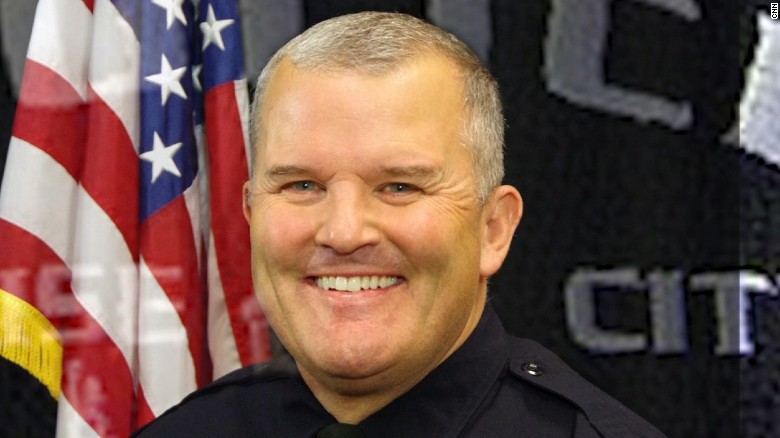“GET FIT OR DIE.” That message, in big bold letters, printed on a T-shirt across the chest of Boise, Idaho, police Cpl. Kevin Holtry, tells you a lot about the man, a military vet and police officer of nearly 20 years, who now uses a wheelchair.
As he slowly wheels himself into the hospital gym, Holtry’s welcoming blue eyes have the look of determination.
“I’m not going to feel sorry for myself,” he said, “You have to show up here every day and say, ‘I’ve got to do something better today than I did yesterday.'”
Paralyzed below the waist, Holtry is grateful to be alive after being shot in the line of duty about two-and-a-half months ago.
He’s finally strong enough to move from basic recovery to focused rehabilitation, which brought him to Craig Hospital in Colorado, a facility that specializes in brain and spinal cord injuries.
While seated on a table during a recent physical therapy session, he grunts and winces as he lifts himself. His arms quiver under the weight of his body, as he tries to scoot, inch-by-inch, across a table, pausing after each movement to catch his breath.
It’s a challenge that feels foreign to this 49-year-old CrossFit fanatic, but one he embraces as a mere part of the job, a consequence of being a police officer.
“When you go into these types of situations, you know that it’s dangerous. That’s why you’re there,” Holtry said. “And you know that the end game is possibly either getting hurt or even getting killed. That’s just the way it is.”
The shooting
That grim possibility turned into stark reality for Holtry on November 11, 2016.
Holtry, a 17-year veteran of the Boise Police Department and part of the Special Operations Unit, was doing a yard-to-yard search for a suspect involved in a shooting and carjacking.
It was “daylight and there’s a lot of places to hide in this particular area,” Holtry recalled. “He was concealed and I was the first guy that really came into contact and ended up being just a few feet from him.”
The suspect opened fire before Holtry had time to react. He was shot five times, immediately collapsing as bullets pierced both his legs, his stomach and spinal cord.
“I knew I was paralyzed immediately. … I scraped up my forearm real bad trying to move in this driveway and dirt alley and I was trying to turn over.”
As Holtry lay helpless, the suspect kept firing. He shot fellow officer, Cpl. Chris Davis, who survived, and fatally wounded Jardo, a K-9 police dog.
Jardo was the “biggest hero of the day,” Holtry said.
He credits the dog with saving his life. Without being commanded, Jardo jumped on the shooter and bit him, providing fellow officers the opportunity to take down the suspect.
“It just breaks my heart because that dog is just doing what he’s supposed to do and he paid the ultimate sacrifice,” Holtry said.
The suspect also was killed in the shootout.
Recovery and rehabilitation
While Holtry feels fortunate to have survived, his most heroic feat has come along the road to recovery, where he has battled a mountain of adversity with seemingly endless optimism.
Three weeks after the shooting, doctors amputated Holtry’s infected left leg. It was one of at least 16 surgeries he has endured.
A rod holds together his right leg. Bullet fragments remain in his body. And Holtry still has no feeling from his waist down.
Between hours of grueling physical therapy and arduous wheelchair fittings, Holtry fights through periodic nerve spasms that strike like “a weird lightning bolt feeling” when he least expects it. Like when he’s rolling down the hall in his wheelchair.
He stops.
He grimaces in extreme pain.
Then he breathes and keeps moving.
Even everyday activities remain challenging. “It sounds crazy, but when I started in bed, you have to learn to dress yourself,” Holtry said. “The first time I did it took me an hour. And now it’s about 18 minutes.” With a big smile he added, “I’m shaving a lot of time off.”
Holtry radiates positivity. He’s determined to reclaim his independence.
He draws strength from visits by fellow officers and cards of encouragement sent by strangers “from New Jersey to Wyoming.”
Holtry beams with appreciation when talking about how the “guys on his team” are outfitting his house for his wheelchair when he returns home.
But nothing is more motivating than his girlfriend and his daughters, age 12 and 15.
It’s still too early to know whether Holtry’s paralysis is permanent, but Holtry says walking isn’t the goal. “They’re like, ‘what are you going to do (today)?’ and I’m like, ‘it’s another day at the salt mine. I’m just going to grind it out, do what I have to do and, you know, give 110%.'”
That work ethic and attitude make Holtry the “ideal rehabilitation patient,” said his physician, Dr. Mark Johansen.
“He’s motivated. He’s bright. He maintains a sense of humor. He’s a warrior.”
